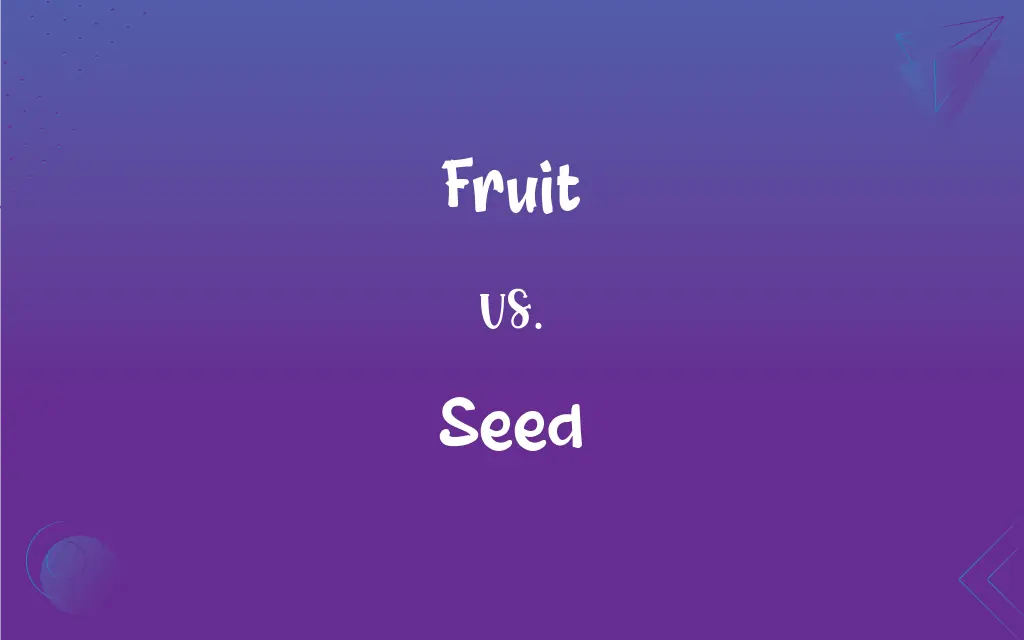Fruit vs. Seed: What's the Difference?
Edited by Janet White || By Harlon Moss || Updated on October 4, 2023
A fruit is the mature ovary of a flowering plant, often containing seeds; a seed is an embryonic plant enclosed in a protective covering.

Key Differences
A fruit emerges from the ovary of a flowering plant after fertilization, often serving as a vessel that encloses and protects seeds. In contrast, a seed is an embryonic plant itself, encapsulated within a protective shell, ready to germinate under the right conditions.
While fruits can be fleshy like apples or berries, they can also be dry like nuts or pods. Seeds, on the other hand, are generally found inside fruits, carrying the genetic information necessary for the growth of a new plant.
Fruits play a significant role in the reproduction strategy of plants by attracting animals for consumption, which consequently assists in seed dispersal. Seeds, while benefiting from this dispersal mechanism, are equipped to start a new life cycle once they find a conducive environment.
One can find multiple seeds within a single fruit, such as in watermelon or kiwi, whereas a seed signifies the potential start of a single new plant. Furthermore, not all fruits are palatable or consumed by humans or animals, but they still serve the primary function of seed protection and dispersal.
In culinary contexts, the word "fruit" generally refers to plant parts that are sweet or tart, such as apples or oranges. The term "seed" remains consistent in referring to the embryonic plants waiting for the right conditions to germinate, like sunflower seeds or pumpkin seeds.
ADVERTISEMENT
Comparison Chart
Definition
Mature ovary of a flowering plant
Embryonic plant enclosed in a protective covering
Role
Protection and dispersal of seeds
Germination and growth of a new plant
Location
Develops from the ovary of the flower
Found inside the fruit or directly from the plant
Varieties
Can be fleshy (apple) or dry (nut)
Typically consistent in form but varies in size
Culinary context
Often sweet or tart parts of plants
Usually the embryonic part ready for germination
ADVERTISEMENT
Fruit and Seed Definitions
Fruit
Fruit is the matured ovary of a flowering plant.
After flowering, the plant started developing fruit.
Seed
Seed is an embryonic plant encased in a cover.
Inside every seed is the potential for an entire plant.
Fruit
Fruit is a product of plant fertilization.
After the flowers were pollinated, they transformed into fruit.
Seed
Seed is the beginning of a new plant life.
The gardener planted the seed, anticipating a new plant.
Fruit
Fruit is a reproductive structure in plants.
The tree's branches were laden with fruit in the summer.
Seed
Seed requires specific conditions to germinate.
Once the seed gets water, it starts the germination process.
Fruit
Fruit often holds the seeds inside it.
Cutting the fruit open revealed numerous tiny seeds.
Seed
Seed contains the genetic material for plant growth.
The seed held the DNA blueprint for its future growth.
Fruit
Fruit can be a vessel for seed protection and dispersal.
Birds often eat the fruit and disperse its seeds elsewhere.
Seed
Seed is usually found inside a fruit.
After eating the fruit, she saved the seed for planting.
Fruit
The ripened ovary or ovaries of a seed-bearing plant, together with accessory parts, containing the seeds and occurring in a wide variety of forms.
Seed
A mature plant ovule containing an embryo.
Fruit
An edible, usually sweet and fleshy form of such a structure.
Seed
A small dry fruit, spore, or other propagative plant part.
Fruit
A part or an amount of such a plant product, served as food
Fruit for dessert.
Seed
Seeds considered as a group
A farmer buying seed.
FAQs
Where can one typically find a seed?
A seed is typically found inside a fruit, though some plants have seeds directly on them.
Can a fruit exist without seeds?
Yes, some fruits, like seedless grapes, have been cultivated to not have mature seeds.
Are tomatoes fruits or vegetables?
Botanically speaking, tomatoes are fruits; however, in culinary contexts, they are treated as vegetables.
What makes a fruit sweet or tart?
The taste of fruit is influenced by its sugar, acid, mineral, and water content.
What role does a seed play in reproduction?
A seed contains the genetic information for a new plant, playing a crucial role in plant reproduction.
Do all flowering plants produce fruit?
All flowering plants produce fruit in a botanical sense, though not all are edible or recognizable as fruit in a culinary sense.
What's the purpose of a fruit for a plant?
A fruit primarily serves for the protection and dispersal of seeds.
Can seeds grow without being inside a fruit?
Yes, some plants disperse seeds that aren't encased in a traditional fruit.
Can you eat every type of fruit?
No, not all fruits are edible; some might be toxic or simply unpalatable.
Is it necessary for a fruit to have seeds inside it?
While many fruits contain seeds, it's not a strict rule; some fruits are seedless.
What is seed dormancy?
Seed dormancy is a period during which a viable seed doesn't germinate even under favorable conditions.
How long can a seed remain viable?
Seed viability varies; some seeds remain viable for a short period, while others can germinate after many years if stored properly.
How does a seed become a plant?
A seed germinates under the right conditions, growing roots, a shoot, and eventually maturing into a plant.
How do seeds disperse in nature?
Seeds disperse through various means: wind, water, animals consuming the fruit, or even explosive mechanisms.
Is every seed capable of germination?
Not every seed is viable; it needs to be mature and undamaged, with the right conditions for germination.
Why do some plants produce fruit?
Plants produce fruit primarily for seed protection and dispersal.
Why are some fruits fleshy and others dry?
The nature of fruit (fleshy or dry) is an evolutionary adaptation based on the best method for seed dispersal and protection.
Can a seed produce more than one plant?
Typically, a seed gives rise to a single plant, but some exceptions might occur.
What's the difference between fruit in culinary and botanical terms?
Culinary fruits are usually sweet or tart plant parts, while botanical fruits are mature ovaries of flowering plants, irrespective of taste.
What is a fruit in botanical terms?
In botanical terms, a fruit is the mature ovary of a flowering plant.
About Author
Written by
Harlon MossHarlon is a seasoned quality moderator and accomplished content writer for Difference Wiki. An alumnus of the prestigious University of California, he earned his degree in Computer Science. Leveraging his academic background, Harlon brings a meticulous and informed perspective to his work, ensuring content accuracy and excellence.
Edited by
Janet WhiteJanet White has been an esteemed writer and blogger for Difference Wiki. Holding a Master's degree in Science and Medical Journalism from the prestigious Boston University, she has consistently demonstrated her expertise and passion for her field. When she's not immersed in her work, Janet relishes her time exercising, delving into a good book, and cherishing moments with friends and family.































































